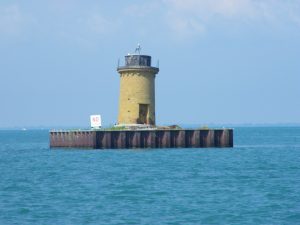In 1683, King Louis XIV sent La Mothe Cadillac to New France with the mission to prosper from the fur trade at Michilimackinac. Little did he know that his mission would later spawn a push for Grand Portage at the Detroit River and establish an iconic fort that is celebrated today. In 1701, Cadillac set sail from Montreal with over 200 automakers to build a port south of Lake Ste. Claire. After having the king’s blessing, they passed Jefferson Avenue and Veterans Memorial onto dry ground where he named his settlement Fort Ponchartrain, commemorating Count Ponchartrain who showed interest in the enterprise. Not only was this venture for efficient and safe trading but also opened up a new era; being one of the first European settlements with women in Michigan.
De la Mothe Cadillac was sent to New France in 1683 by King Louis XIV of France and went on to prosper from the fur trade at Michilimackinac. Despite facing opposition from the Jesuit missionaries over his sale of intoxicants to the Indians, Cadillac persisted and ultimately made a great success of himself. It was an opportune time for the king to grant the Jesuits’ request to close the upper Great Lakes to those outside the mission, as there was an over-supply of furs and Louis XIV was struggling to finance his army’s forays in Europe.
Seeing this, Cadillac proposed to the King to establish a new outpost in the area south of Lake Ste. Claire and the Detroit River was an attractive settlement for both traders and settlers. After being met with the king’s blessing, Cadillac set sail from Montreal with over 200 men in the spring of 1701. The names of those on board included Beaufait, Morain, Cadway, Tronbles, Choices, St. Aubin, Proncusal, Rivard, and Gurne, each remembered and celebrated today.

On July 23, 1701, they passed the shores and proudly landed between present Jefferson Avenue and the Veterans Memorial. Cadillac named his fort after Count Ponchartrain who had shown interest in the venture, and to further encourage others, he asked his wife and Mme. de Tonty, wife of his second in command, to move to the fort becoming the first European women in Michigan. To reassure the local natives, Cadillac made it clear that the French only wanted a convenient place for them to trade their furs without threatening their lifestyle or peace, even though as a precaution, Indians were ordered out of the fort at sundown.
To provide access to the river, Cadillac gave grants of land that were long and narrow, stretching inland as far as three miles; these became known as “ribbon farms”. The presence of the fort gave humans and animals access to the water, while also providing a means for goods to be transported to the fort. Cadillac’s careful approach led to the area quickly being surrounded by friendly Miamis, Hurons, Chippewas, and Ottawas, with the Potawatomi arriving later.
His skillful maneuvering won over many of his detractors, and he was appointed the Governor of the Louisiana region in 1710, an appointment that further solidified his success.
La Mothe Cadillac’s decision to find a settlement in the Detroit River has become an important part of Michigan’s history. Despite opposition from both the King and Jesuits, he showed a deep commitment to his venture and set a path for future trading, settlements, and immigration. He brought with him over two hundred men, making them the first people recorded as European settlers in Michigan, and his wife entered alongside Madame de Tonty, famously becoming the first European woman of the region. While planning for the future safety of those at the fort, Cadillac also declared that he had only wanted to provide the local native people with a more convenient space for trading without threatening their way of life. Thus, La Mothe Cadillac’s fort came to symbolize both recognition of the impressive influence he was able to exercise over the region, as well as protecting it from certain threats and causing further opportunities.
[button link=”https://www.gpwmi.us/community/page/cadillacs-village” newwindow=”yes”]Read More About De La Mothe Cadillac[/button]
